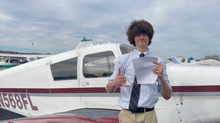Aviation Safety and the Consequences of Inexperience: A Case Study of N969WD
- Doug Auclair

- Apr 9
- 4 min read
Aviation demands a high degree of skill, knowledge, and discipline. The ability to fly safely is not solely determined by the acquisition of a pilot certificate but by continued learning, prudent decision-making, and adherence to best practices. The March 10, 2023, accident involving a Zenith Zodiac 601XL (N969WD) in La Veta, Colorado, highlights the dangers of low total flight time, inexperience in a new make and model, and a lack of sound aeronautical decision-making. This incident is best analyzed through the FAA’s PAVE model, which evaluates risk factors across four categories: Pilot, Aircraft, enVironment, and External pressures (FAA, 2021).
Pilot: Lack of Experience and Transition Training The pilot, aged 27, had recently earned his private pilot certificate and had accumulated only 65 total flight hours, with a mere 10 hours as pilot-in-command. Most critically, he had zero experience in the Zenith Zodiac 601XL, an experimental aircraft with unique handling characteristics. The transition to a new aircraft type requires training beyond the minimum certification standards. While a private pilot certificate demonstrates basic competency, it does not guarantee proficiency in unfamiliar aircraft.
Without structured transition training, the pilot lacked the ability to anticipate the aircraft’s handling nuances, particularly in high-wind conditions. Experimental aircraft often have different performance parameters than standard certificated aircraft, including differences in stall behavior, weight and balance sensitivity, and control responsiveness. Failure to undergo training in the specific make and model significantly increased risk.
Aircraft: Understanding Performance Limitations The Zenith Zodiac 601XL is a lightweight, homebuilt aircraft that requires precise control inputs to maintain stable flight, particularly in turbulent conditions. On the day of the accident, the pilot was attempting to take off in an aircraft he had never flown before, with no recorded instruction in its flight characteristics. The aircraft reportedly stalled at approximately 100 feet AGL, indicating improper energy management. The pilot’s failure to maintain sufficient airspeed resulted in an exceedance of the critical angle of attack, leading to an aerodynamic stall and impact with terrain.
Additionally, post-accident analysis found no mechanical anomalies with the engine, contradicting the pilot’s claim of an engine failure. The evidence suggests that unfamiliarity with the aircraft and mishandling in turbulent conditions were the primary causes of the loss of control.
enVironment: Challenging Weather Conditions The pilot chose to depart in conditions that were beyond the capabilities of his experience level. Wind at the time of takeoff was 35 to 40 knots with gusts, an exceptionally challenging environment for any light aircraft, especially an experimental category airplane. Such winds create significant mechanical turbulence and wind shear, requiring advanced piloting skills and experience in aircraft control.
The previous owner of the aircraft, who was present at the time of the accident, advised the pilot against flying that day. Despite this expert recommendation, the pilot proceeded with the flight, demonstrating poor risk assessment. The decision to fly in such conditions without prior experience in the aircraft illustrates a serious deficiency in aeronautical decision-making.
External Pressures: Get-There-Itis and Poor Judgment The desire to complete a flight despite significant risk factors is a well-documented hazard in aviation. The pilot was attempting to ferry the aircraft to Texas, creating a psychological pressure to depart regardless of conditions. This “get-there-itis” led to the dismissal of prudent safety considerations, as the pilot ignored warnings from the aircraft’s previous owner.
External pressures can cloud judgment, causing pilots to take unnecessary risks. Recognizing and mitigating these pressures is a fundamental skill that comes with experience and disciplined decision-making. In this case, the pilot’s determination to depart led to a failure to conduct an objective preflight risk assessment.
The Role of Transition Training in Accident Prevention Transition training is critical when moving from one aircraft type to another. Even experienced pilots undergo transition training when stepping into unfamiliar aircraft. In this case, the pilot’s lack of structured transition training was a major contributing factor. Such training provides knowledge on:
Aircraft handling characteristics
Stall behavior and recovery techniques
Weight and balance considerations
Emergency procedures specific to the aircraft
Without this essential knowledge, the pilot was ill-equipped to handle the aircraft in routine conditions, let alone in extreme turbulence and high winds.
Certification is Just the Beginning Earning a private pilot certificate is an achievement, but it represents only the foundation of a pilot’s learning journey. The reality is that a checkride demonstrates competency at the absolute minimum acceptable standard. Long-term aviation safety requires ongoing education, disciplined decision-making, and adherence to risk management principles.
This accident underscores the importance of:
Gaining experience in a new aircraft through structured transition training.
Understanding aircraft performance characteristics before flight.
Assessing environmental risks realistically and conservatively.
Resisting external pressures that compromise safety.
By applying the principles of the FAA PAVE model, pilots can critically assess risk and make informed decisions. This case serves as a cautionary tale that the difference between a successful flight and an accident often comes down to preparation, training, and judgment.
References:
Federal Aviation Administration. (2021). Risk Management Handbook (FAA-H-8083-2A). U.S. Department of Transportation. https://www.faa.gov/sites/faa.gov/files/regulations_policies/handbooks_manuals/aviation/Risk_Management_Handbook.pdf
National Transportation Safety Board. (2024). Aviation Investigation Final Report: CEN23LA128. U.S. Government. https://data.ntsb.gov/Docket?ProjectID=106865
















































